
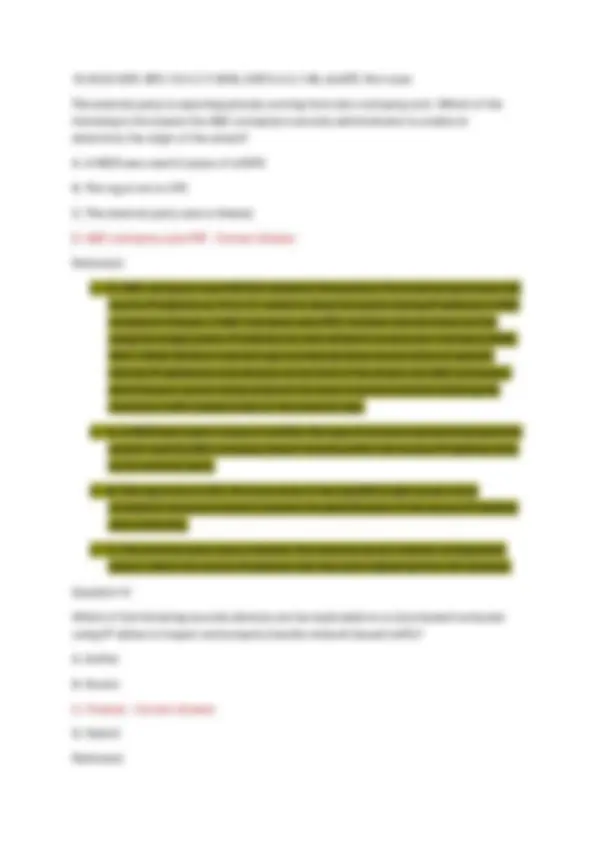
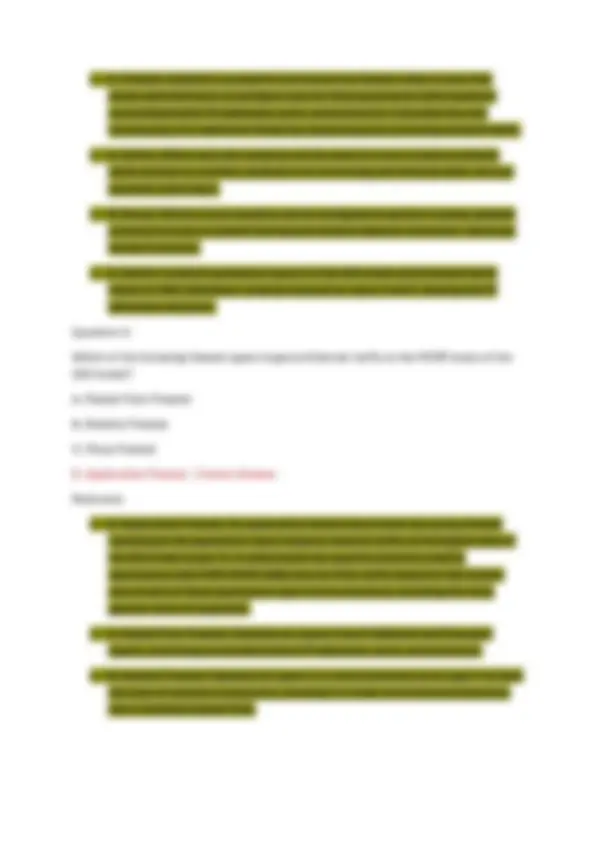
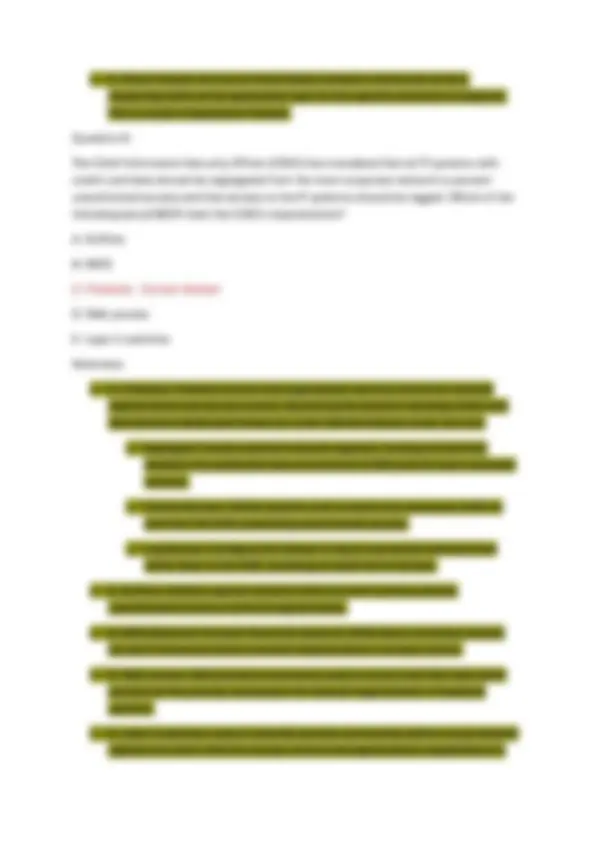
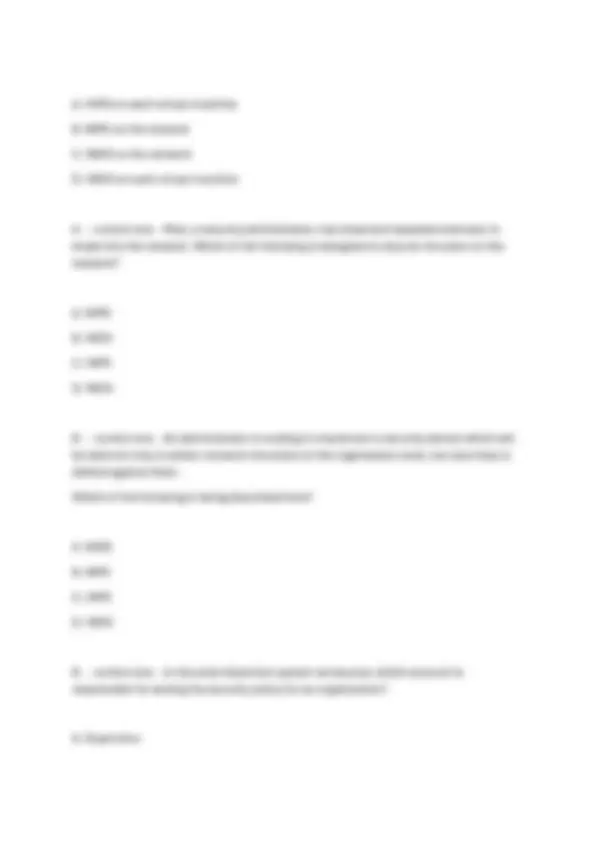
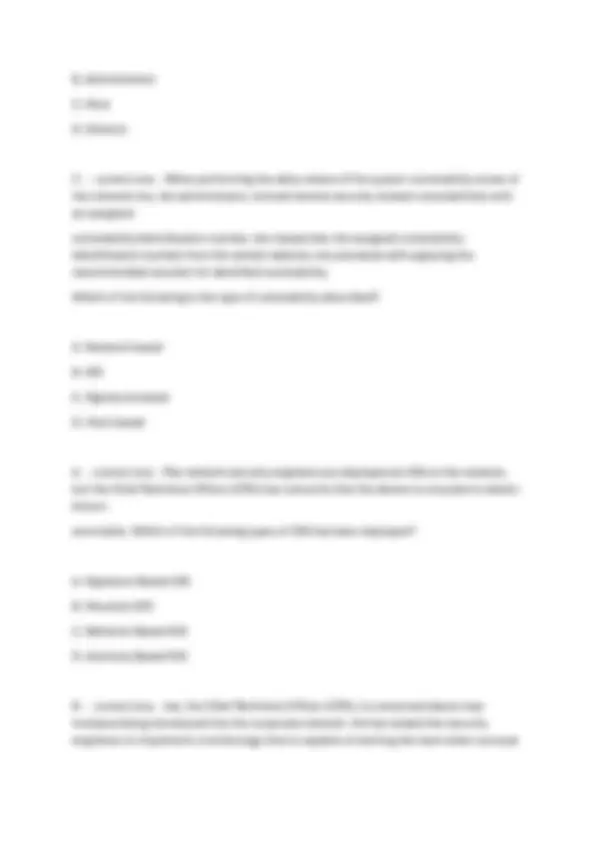
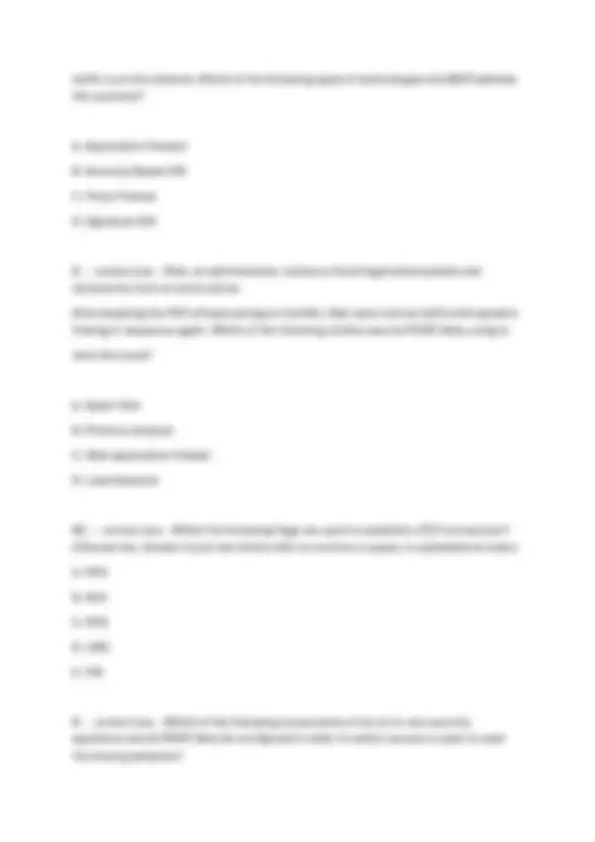
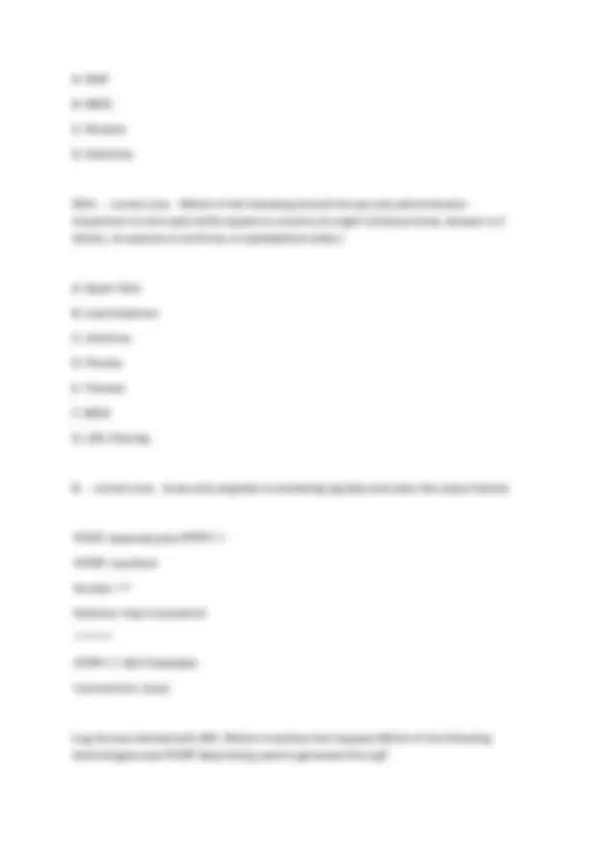
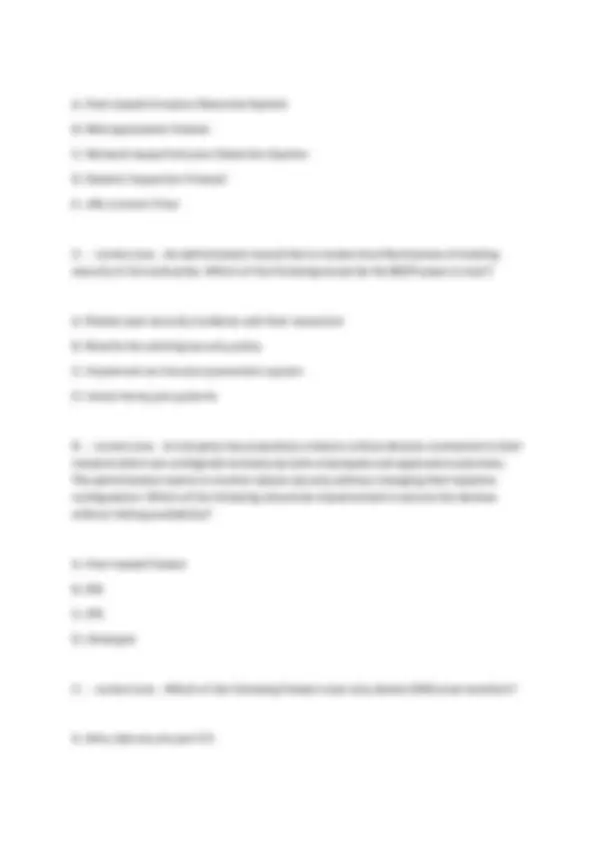
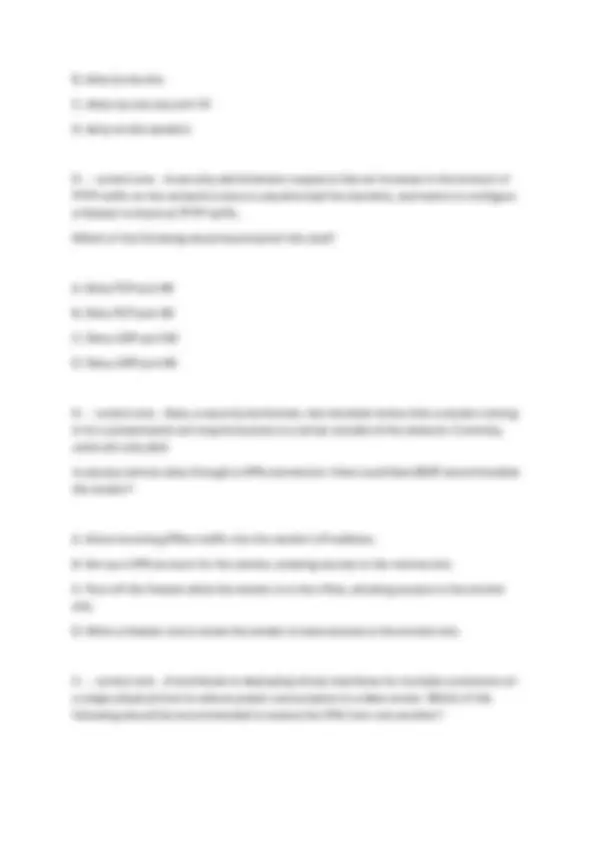

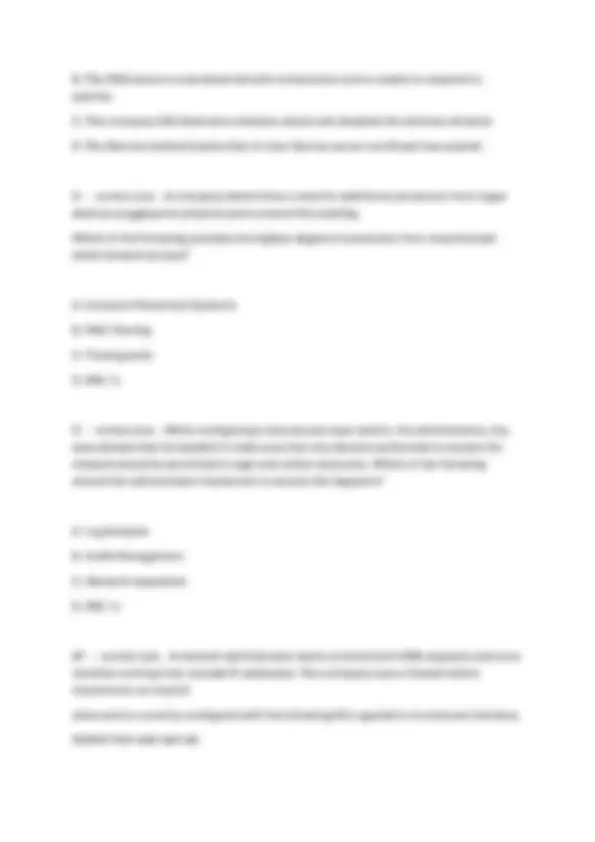

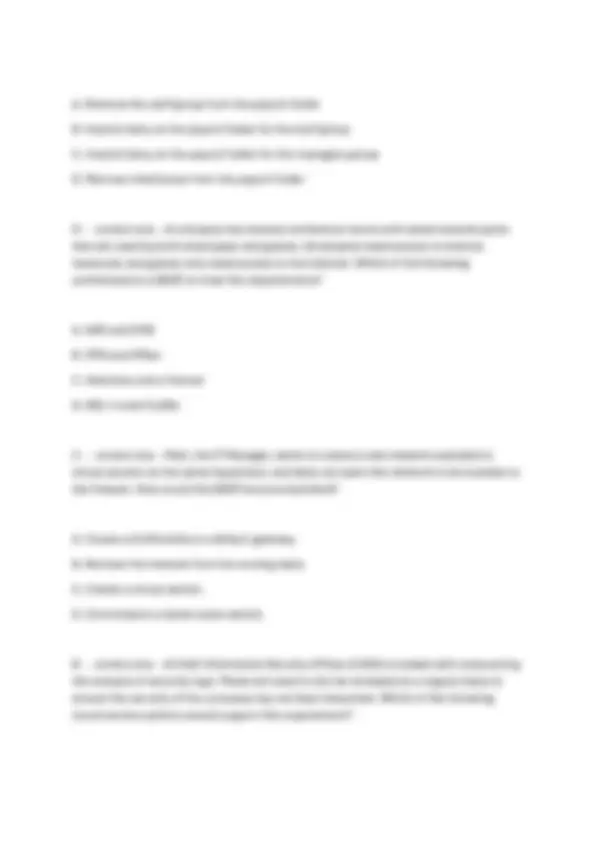
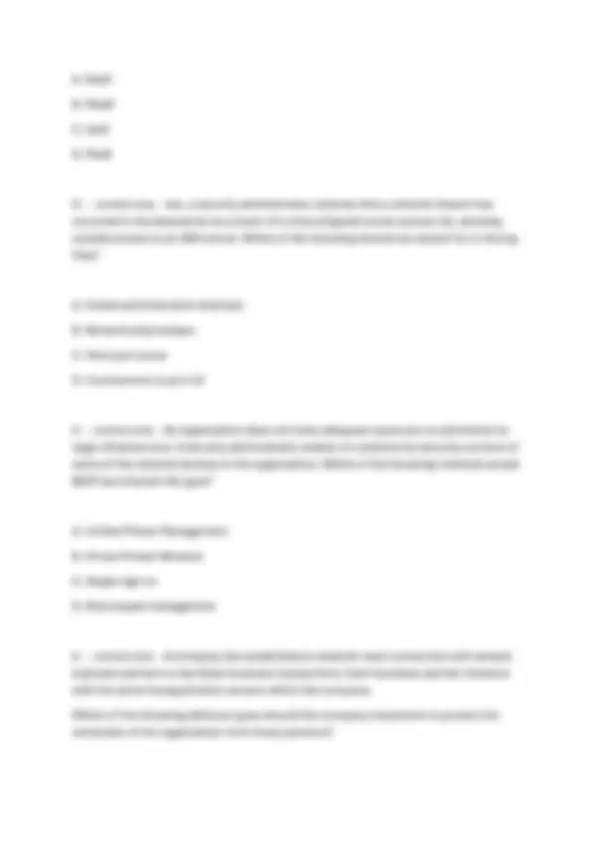
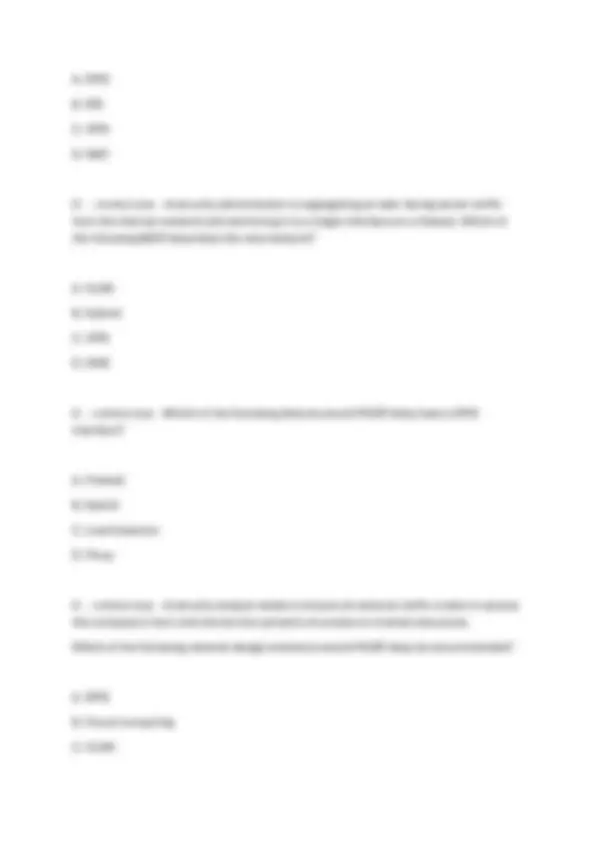
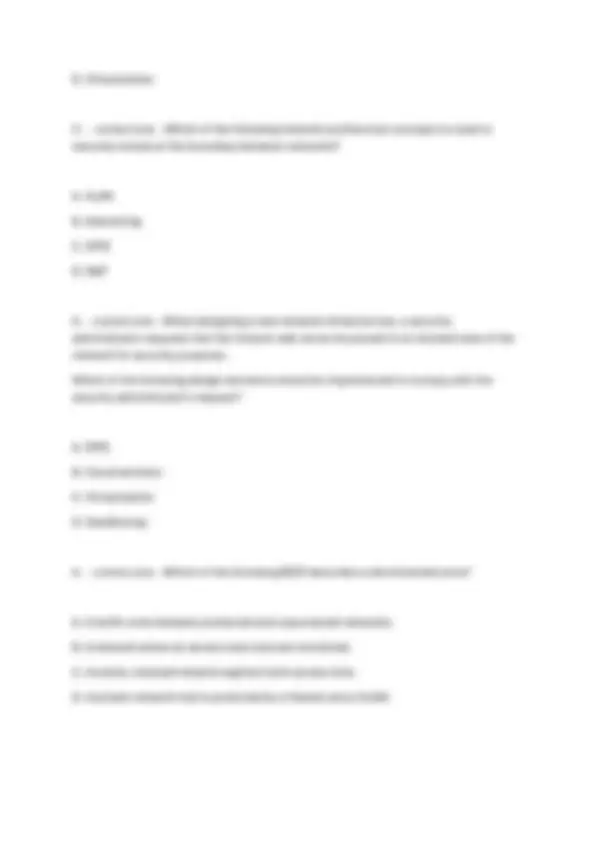
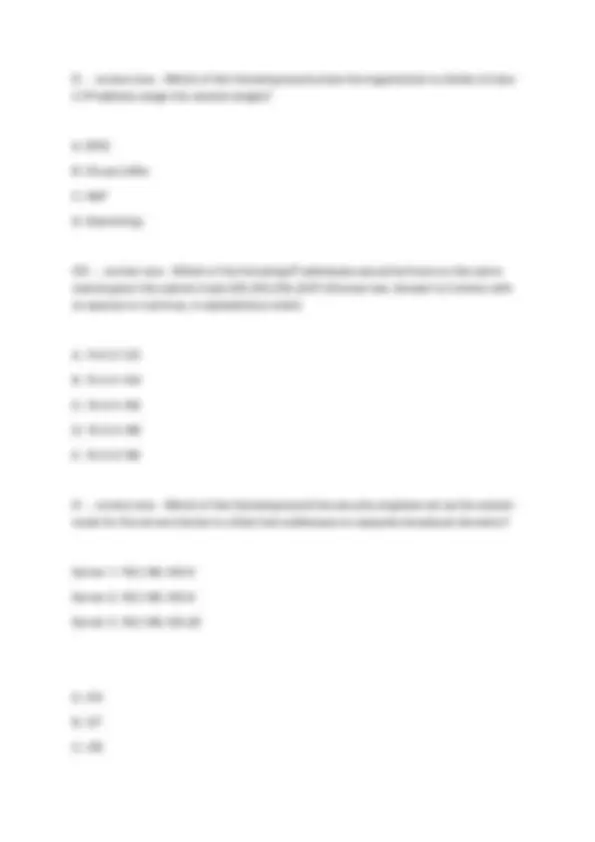
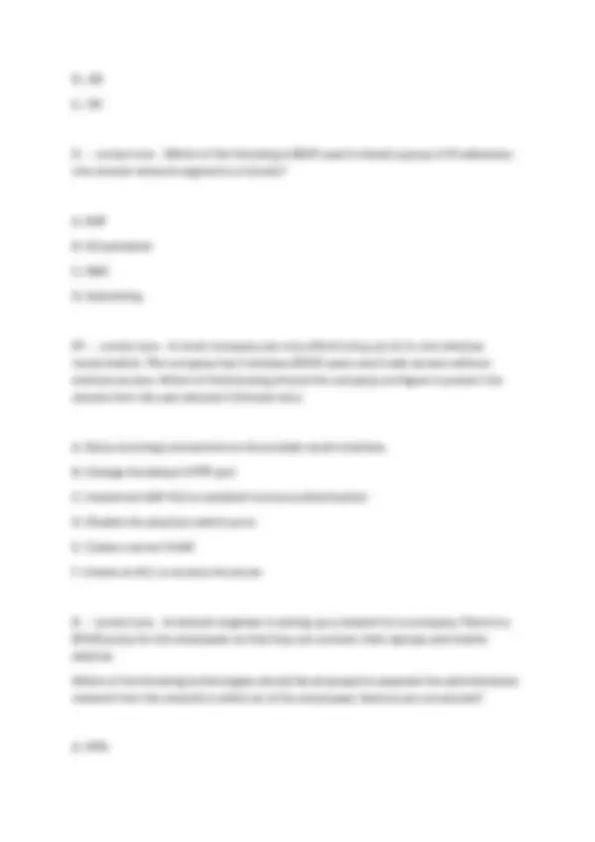
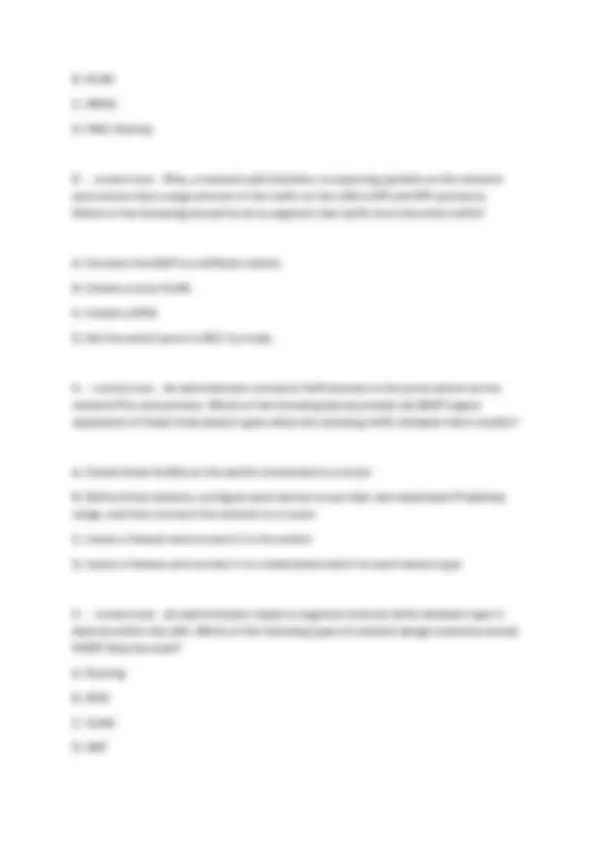



Study with the several resources on Docsity

Earn points by helping other students or get them with a premium plan


Prepare for your exams
Study with the several resources on Docsity

Earn points to download
Earn points by helping other students or get them with a premium plan
Community
Ask the community for help and clear up your study doubts
Discover the best universities in your country according to Docsity users
Free resources
Download our free guides on studying techniques, anxiety management strategies, and thesis advice from Docsity tutors
CompTIA Security+ Certification Guide 2025: Complete Study Plan, Exam Objectives, and Real World Cybersecurity Scenarios
Typology: Exams
1 / 28

This page cannot be seen from the preview
Don't miss anything!





















Here are the multiple-choice questions with rationales and the correct answers indicated: Question 1: Sara, the security administrator, must configure the corporate firewall to allow all public IP addresses on the internal interface of the firewall to be translated to one public IP address on the external interface of the same firewall. Which of the following should Sara configure? A. PAT - Correct Answer B. NAP C. DNAT D. NAC Rationale:
Question 2: Which of the following devices is MOST likely being used when processing the following? "1 PERMIT IP ANY ANY EQ 80 2 DENY IP ANY ANY" A. Firewall - Correct Answer B. NIPS C. Load Balancer D. URL fitter Rationale:
B - - correct ans- - Which of the following devices would be MOST useful to ensure availability when there are a large number of requests to a certain website? A. Protocol analyzer B. Load balancer C. VPN concentrator D. Web security gateway D - - correct ans- - Pete, the system administrator, wishes to monitor and limit users' access to external websites. Which of the following would BEST address this? A. Block all traffic on port 80. B. Implement NIDS. C. Use server load balancers. D. Install a proxy server. C - - correct ans- - Mike, a network administrator, has been asked to passively monitor network traffic to the company's sales websites. Which of the following would be BEST suited for this task? A. HIDS B. Firewall C. NIPS D. Spam filter A - - correct ans- - Which of the following should be deployed to prevent the transmission of malicious traffic between virtual machines hosted on a singular physical device on a network?
A. HIPS on each virtual machine B. NIPS on the network C. NIDS on the network D. HIDS on each virtual machine A - - correct ans- - Pete, a security administrator, has observed repeated attempts to break into the network. Which of the following is designed to stop an intrusion on the network? A. NIPS B. HIDS C. HIPS D. NIDS B - - correct ans- - An administrator is looking to implement a security device which will be able not only to detect network intrusions at the organization level, but also help to defend against them. Which of the following is being described here? A. NIDS B. NIPS C. HIPS D. HIDS B - - correct ans- - In intrusion detection system vernacular, which account is responsible for setting the security policy for an organization? A. Supervisor
traffic is on the network. Which of the following types of technologies will BEST address this scenario? A. Application Firewall B. Anomaly Based IDS C. Proxy Firewall D. Signature IDS B - - correct ans- - Matt, an administrator, notices a flood fragmented packet and retransmits from an email server. After disabling the TCP offload setting on the NIC, Matt sees normal traffic with packets flowing in sequence again. Which of the following utilities was he MOST likely using to view this issue? A. Spam filter B. Protocol analyzer C. Web application firewall D. Load balancer BC - - correct ans- - Which the following flags are used to establish a TCP connection? (Choose two. Answer is just two letters with no comma or space, in alphabetical order.) A. PSH B. ACK C. SYN D. URG E. FIN B - - correct ans- - Which of the following components of an all-in-one security appliance would MOST likely be configured in order to restrict access to peer-to-peer file sharing websites?
A. Spam filter B. URL filter C. Content inspection D. Malware inspection C - - correct ans- - Pete, the system administrator, wants to restrict access to advertisements, games, and gambling websites. Which of the following devices would BEST achieve this goal? A. Firewall B. Switch C. URL content filter D. Spam filter D - - correct ans- - The administrator receives a call from an employee named Joe. Joe says the Internet is down and he is receiving a blank page when typing to connect to a popular sports website. The administrator asks Joe to try visiting a popular search engine site, which Joe reports as successful. Joe then says that he can get to the sports site on this phone. Which of the following might the administrator need to configure? A. The access rules on the IDS B. The pop up blocker in the employee's browser C. The sensitivity level of the spam filter D. The default block page on the URL filter B - - correct ans- - Layer 7 devices used to prevent specific types of html tags are called:
C. Routers D. Switches DEG - - correct ans- - Which of the following should the security administrator implement to limit web traffic based on country of origin? (Choose three. Answer is 3 letters, no spaces or commas, in alphabetical order.) A. Spam filter B. Load balancer C. Antivirus D. Proxies E. Firewall F. NIDS G. URL filtering B - - correct ans- - A security engineer is reviewing log data and sees the output below: POST: /payload.php HTTP/1. HOST: localhost Accept: / Referrer: http://localhost/
HTTP/1.1 403 Forbidden Connection: close Log: Access denied with 403. Pattern matches form bypass Which of the following technologies was MOST likely being used to generate this log?
A. Host-based Intrusion Detection System B. Web application firewall C. Network-based Intrusion Detection System D. Stateful Inspection Firewall E. URL Content Filter C - - correct ans- - An administrator would like to review the effectiveness of existing security in the enterprise. Which of the following would be the BEST place to start? A. Review past security incidents and their resolution B. Rewrite the existing security policy C. Implement an intrusion prevention system D. Install honey pot systems B - - correct ans- - A company has proprietary mission critical devices connected to their network which are configured remotely by both employees and approved customers. The administrator wants to monitor device security without changing their baseline configuration. Which of the following should be implemented to secure the devices without risking availability? A. Host-based firewall B. IDS C. IPS D. Honeypot C - - correct ans- - Which of the following firewall rules only denies DNS zone transfers? A. deny udp any any port 53
A. Implement a virtual firewall B. Install HIPS on each VM C. Virtual switches with VLANs D. Develop a patch management guide B - - correct ans- - A router has a single Ethernet connection to a switch. In the router configuration, the Ethernet interface has three sub-interfaces, each configured with ACLs applied to them and 802.1q trunks. Which of the following is MOST likely the reason for the sub-interfaces? A. The network uses the subnet of 255.255.255.128. B. The switch has several VLANs configured on it. C. The sub-interfaces are configured for VoIP traffic. D. The sub-interfaces each implement quality of service. A - - correct ans- - Joe, a technician at the local power plant, notices that several turbines had ramped up in cycles during the week. Further investigation by the system engineering team determined that a timed .exe file had been uploaded to the system control console during a visit by international contractors. Which of the following actions should Joe recommend? A. Create a VLAN for the SCADA B. Enable PKI for the MainFrame C. Implement patch management D. Implement stronger WPA2 Wireless D - - correct ans- - The security administrator needs to manage traffic on a layer 3 device to support FTP from a new remote site. Which of the following would need to be implemented?
A. Implicit deny B. VLAN management C. Port security D. Access control lists AF - - correct ans- - Matt, the network engineer, has been tasked with separating network traffic between virtual machines on a single hypervisor. Which of the following would he implement to BEST address this requirement? (Choose two. Answer is just two letters with no comma or space, in alphabetical order.) A. Virtual switch B. NAT C. System partitioning D. Access-list E. Disable spanning tree F. VLAN C - - correct ans- - A database administrator contacts a security administrator to request firewall changes for a connection to a new internal application. The security administrator notices that the new application uses a port typically monopolized by a virus. The security administrator denies the request and suggests a new port or service be used to complete the application's task. Which of the following is the security administrator practicing in this example? A. Explicit deny B. Port security C. Access control lists
B. The DNS server is overwhelmed with connections and is unable to respond to queries. C. The company IDS detected a wireless attack and disabled the wireless network. D. The Remote Authentication Dial-In User Service server certificate has expired. D - - correct ans- - A company determines a need for additional protection from rogue devices plugging into physical ports around the building. Which of the following provides the highest degree of protection from unauthorized wired network access? A. Intrusion Prevention Systems B. MAC filtering C. Flood guards D. 802.1x D - - correct ans- - While configuring a new access layer switch, the administrator, Joe, was advised that he needed to make sure that only devices authorized to access the network would be permitted to login and utilize resources. Which of the following should the administrator implement to ensure this happens? A. Log Analysis B. VLAN Management C. Network separation D. 802.1x AF - - correct ans- - A network administrator wants to block both DNS requests and zone transfers coming from outside IP addresses. The company uses a firewall which implements an implicit allow and is currently configured with the following ACL applied to its external interface. PERMIT TCP ANY ANY 80
Which of the following rules would accomplish this task? (Choose two. Answer is just two letters with no commas or spaces, in alphabetical order) A. Change the firewall default settings so that it implements an implicit deny http://comptiaexamtest.com B. Apply the current ACL to all interfaces of the firewall C. Remove the current ACL D. Add the following ACL at the top of the current ACLDENY TCP ANY ANY 53 E. Add the following ACL at the bottom of the current ACLDENY ICMP ANY ANY 53 F. Add the following ACL at the bottom of the current ACLDENY IP ANY ANY 53 D - - correct ans- - Users are unable to connect to the web server at IP 192.168.0.20. Which of the following can be inferred of a firewall that is configured ONLY with the following ACL? PERMIT TCP ANY HOST 192.168.0.10 EQ 80 PERMIT TCP ANY HOST 192.168.0.10 EQ 443 A. It implements stateful packet filtering. B. It implements bottom-up processing. C. It failed closed. D. It implements an implicit deny. B - - correct ans- - The Human Resources department has a parent shared folder setup on the server. There are two groups that have access, one called managers and one called staff. There are many sub folders under the parent shared folder, one is called payroll. The parent folder access control list propagates all subfolders and all subfolders inherit the parent permission. Which of the following is the quickest way to prevent the staff group from gaining access to the payroll folder?